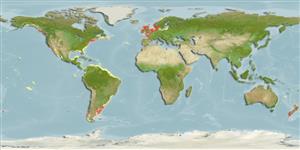Common names from other countries
Classification / Names / Names
Noms communs | Synonymes | Catalog of Fishes (gen., sp.) | ITIS | CoL | WoRMS
Environment: milieu / climate zone / depth range / distribution range
Écologie
; profondeur 0 - 55 m (Ref. 83939). Subtropical
Atlantic Ocean, Pacific Ocean and the Mediterranean.
Length at first maturity / Taille / Poids / Âge
Maturity: Lm ? range ? - ? cm Max length : 10.0 cm TL mâle / non sexé; (Ref. 402)
This is a benthic species found on rocky bottoms particularly in intertidal and subtidal areas (Ref. 83938). It is a burrowing and encrusting species inhabiting hard substrates like rocks, empty mollusk shells, Caryophyllia and Lithothamnion (Ref. 402).
Life cycle and mating behavior
Maturité | Reproduction | Frai | Œufs | Fécondité | Larves
Members of the phylum Phoronida are mostly hermaphroditic. Life cycle: Embryos develop into free-swimming planktotrophic actinotrocha larvae which later sinks to the bottom and metamorphose into benthic adults.
Hansson, H.G. 1999. (Ref. 997)
Statut dans la liste rouge de l'IUCN (Ref. 130435)
statut CITES (Ref. 108899)
Not Evaluated
Not Evaluated
Utilisations par l'homme
| FishSource |
Outils
Plus d'informations
Taille/Âge
Croissance
Longueur-poids
Longueur-longueur
Morphologie
Larves
Abondance
Sources Internet
Estimates based on models
Preferred temperature
(Ref.
115969): 8.6 - 15.8, mean 10.7 (based on 560 cells).
Catégorie de prix
Unknown.
